At last publication day has arrived. Shaping the Wild is available from all good book shops now!
And if you would like to attend the online launch at 7pm on the 2nd of May hit the link below:
Best wishes,
David

At last publication day has arrived. Shaping the Wild is available from all good book shops now!
And if you would like to attend the online launch at 7pm on the 2nd of May hit the link below:
Best wishes,
David


I want to let you know that my book Shaping the Wild will be published on 27th April. It is already available for pre-order at all major booksellers including Amazon. But why not order a copy from your local independent bookshop?
There will be an online launch event on the evening of Tuesday 2nd May. If you would like to attend I would be delighted to see you there. All you need to do is email my publisher, Calon Books, at Maria.vassilopoulos@press.wales.ac.uk and they will send you an invitation with a link to use on the night. The book will be available to order for a discount price at the event.
For those of you living in Wales there will be two live launch events: The first will be in Machynlleth at the Owain Glyndwr Institue on the evening of Wednesday 10th May at 6.30 for 7.00 hosted by Penrallt Bookshop and the second in Bala at Canolfan Plase on the evening of Friday 19th May at 7.30 hosted by Awen Meirion bookshop. The events are free but because space is limited it would be advisable to obtain tickets from the respective bookshops. Copies of the book will be available for purchase on the night and i will be on hand to sign copies.
I very much look forward to your company.
David
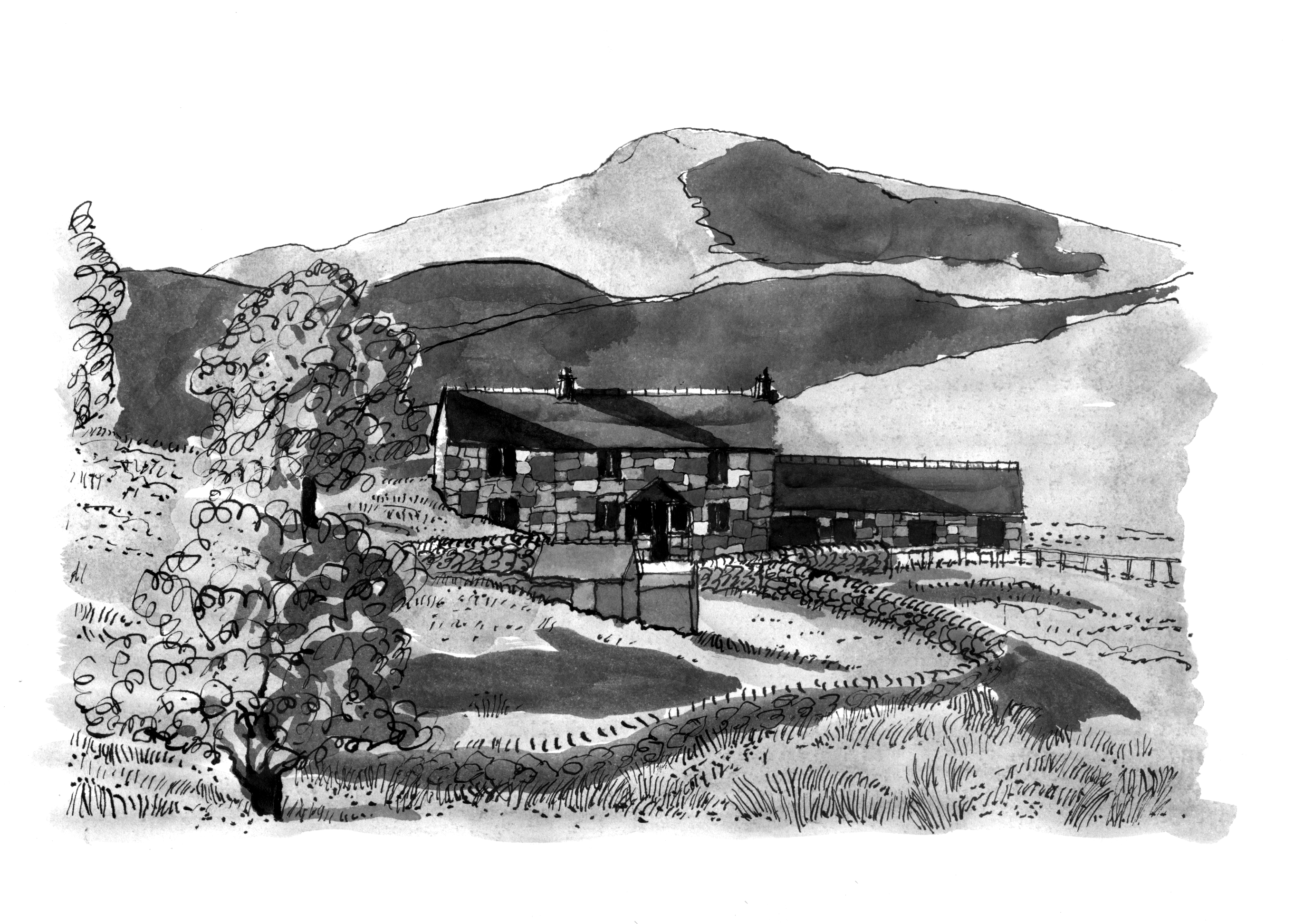

A year ago, almost to the day, I said here that I would not be posting any blogs for a while as I was intent on finishing writing a book. Well, it took longer than I expected but I am nearly there: Shaping the Wild will be published on 27th April this year.
For the last 40 years I have been interested in the intersection of nature conservation and upland farming. In the 80s and 90s I spent 13 years working on the Berwyn Mountains in Wales trying to bring harmony between farmers and conservationists – who had fallen out badly. I have remained interested in this lively and sometimes fractious issue ever since and, having an urge to write, thought a book could be a good contribution to the debate.
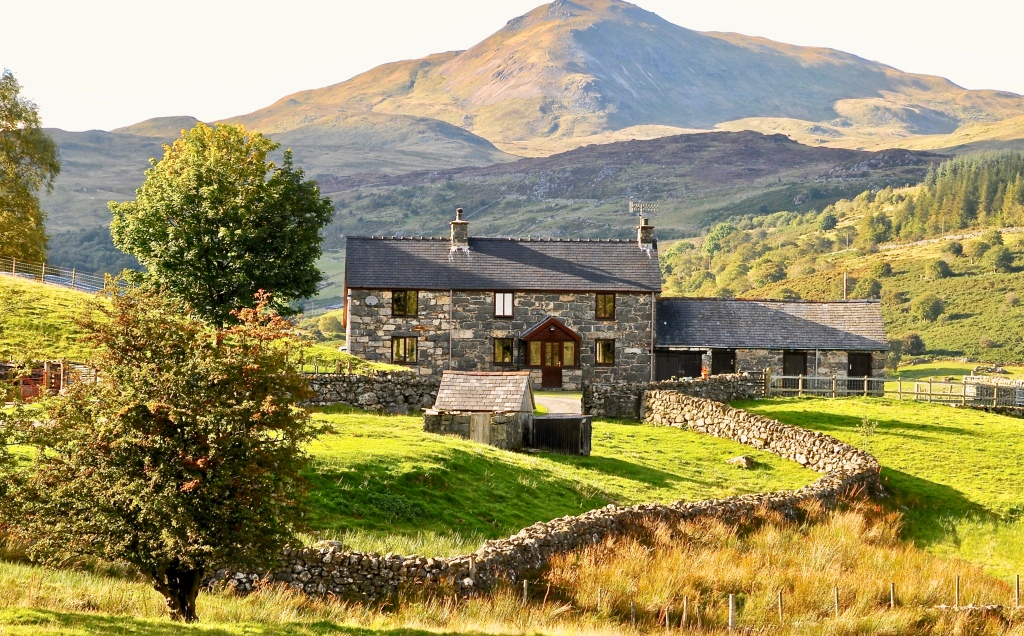
The Berwyn proved to be too sprawling and complex to shape a narrative around, so I began to wonder if I could explore the subject by looking at a single farm. As it happened not far from where I lived was a very particular and suitable place: Craig-y-tân. This beautiful mountain farm is set in stunning landscape and is rich in wildlife. What is more I had known the farmer, Hywel Jones, for many years. I also knew his elderly aunt who was born at Craig-y-tân in 1926 and had fascinating tales about farming in an era almost lost from memory. With Hywel’s blessing, starting in 2014, I spent the next 7 years studying his farm.
What is so important about nature conservation and upland farming?
Over the last 70 years the UK (and it is not alone) has suffered a catastrophic decline in wildlife, and undoubtedly the most significant factor in that has been the intensification of agriculture. With about 75% of our land surface (in Wales that goes up to 80%+) being farmed, it is clear that much of the fate of our biodiversity is linked to agriculture, and in the west and north most of that is in the uplands.
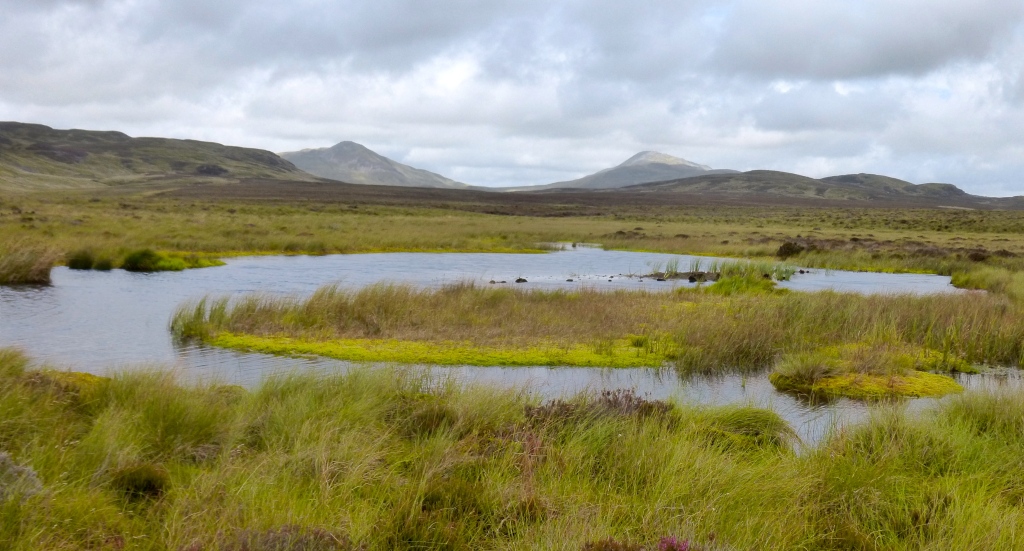
And we are now poised right at a hinge point. Much as I regret Brexit, the EU’s Common Agricultural Policy was a disaster for wildlife. Now, post-Brexit, each of the devolved nations of the UK is finalising new agricultural support schemes. What they come up with could spell either restoration or annihilation for a wildlife rich countryside. The CAP delivered heavily subsidised food and ruined ecosystems – at huge expense to the public purse. That can’t go on: something has to change.
What is particular about Craig-y-tân is that wildlife rich countryside and farming are already co-existing pretty well there; a full range of wildlife habitats are present whilst the land is being farmed by a local family with up-to-date farming methods. And there is a unique aspect to this in Wales: most of the country is still a patchwork of family farms and this community is the backbone of the Welsh language and culture. Hywel’s day to day language is Welsh as was his forebears who worked this rugged place for generations before him. If the balance were to tip away from family farms towards agri-business or large-scale rewilding this could precipitate a cultural and linguistic collapse that would tear at the very fabric of Wales.

In Shaping the Wild I have been exploring this weave of interdependent threads – including myself as an outsider telling an inside story. I wanted to describe and evoke this rich and beautiful place as I strongly believe it is what moves us that causes us to care. I also wanted to understand this issue ‘in the round’ rather than from the kind of preconceived tribal perspective that is all too common on every side. What does it really take for hill farming and nature to live in harmony? That is what Shaping the Wild sets out to explore.
The book will be published in hardback and is beautifully illustrated with drawings by my friend Peter Hanauer.
There will be a series of events to launch and publicise the book here in Wales but for those further afield I am arranging an on-line event which any of you will be able to attend, if you would be interested. It will be on 2nd May ’23 at 7pm UK time. I will post a link to the event here in due course.
I hope to meet you there, David
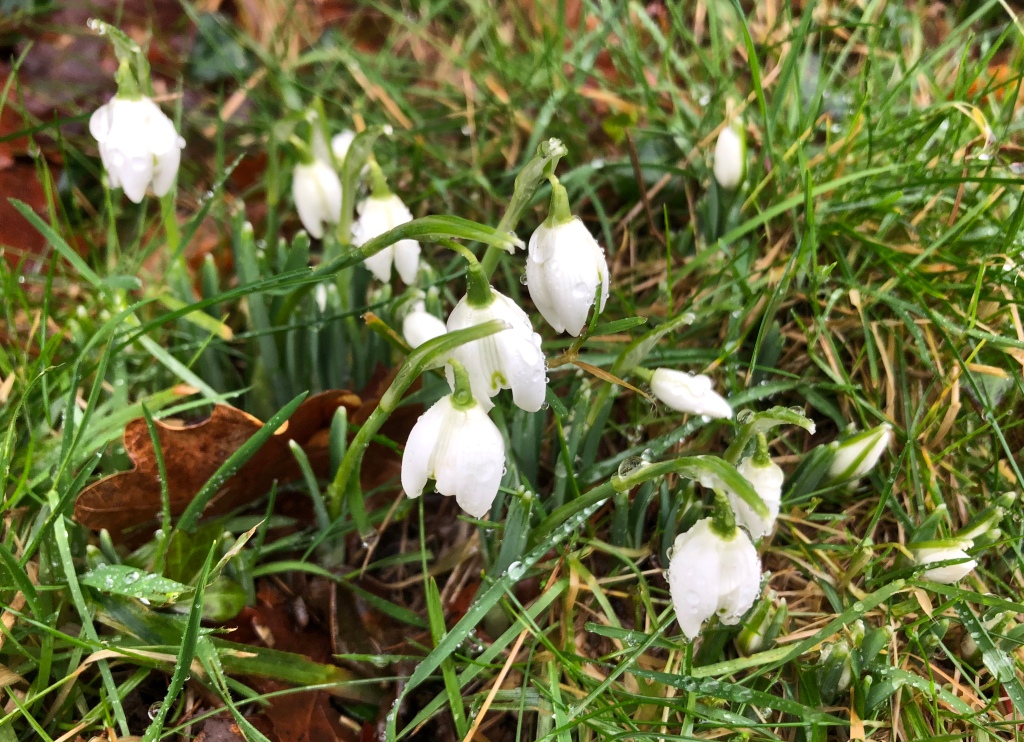
I apologise for the lack of blog-posts in recent months. For sometime I have been writing a book about nature and farming in the Welsh uplands and it has been accepted for publication. I must now revise the manuscript and get it back to the publishers by June – which is keeping me pretty busy. I will post details of the book in due course. I hope normal service will be restored later in the year. Best wishes to all.
It is only a scruffy patch of grass really, about 20 yards square at the back of the churchyard, where nobody will notice it. By late summer the pale swaying grass stems gleam in the afternoon sun, lending a soft haze to the dignified headstones, which they partly obscured. Every headstone here is slate, no doubt hacked from the quarries only a few miles away across the Dyfi.
Churchyards are often one of the few remaining places to find fragments of wildlife-rich grassland, agricultural intensification has destroyed most of it in the farmed landscape. But, like many others, St Peter’s in Machynlleth let a contract for churchyard maintenance, which in effect means two men come twice each summer and strim the grass wall to wall, leaving the cut grass where it lies. This produces a tidy, but featureless, green sward – rather sad for a place set aside to celebrate Creation. In the hope of improving on this we asked the church authorities if they would exclude a portion which we could manage for the benefit wildlife – and they agreed.
I had looked at our patch a few weeks before and counted about 30 species of plants including the grasses. There was nothing unusual, we are not dealing with one of those ‘Lazarus’ situations which sometimes occur when the cutting stops and a mass of orchids, or some other eye-catching plants, come up for air for the first time in decades. But with encouragement, and time, this place should become more interesting and varied. Our proposal was to let the plants grow, flower and set seed, then cut and cart away for compost at the end of summer. This gives the chance for new seedlings to establish, which especially important for annual species. Also, raking up and removing the cut material prevents smothering and over ‘composting’, which only benefits a few robust generalist plants at the expense of more delicate ones, which often prefer less fertile conditions.
At the end of August my friend Tom and I turn out to do the cutting and clearing; Tom is an experienced scyther and has a beautifully balanced Austrian scythe that he keeps razor sharp. I am in the ‘builders-mate’ role with a rake and wheelbarrow. Tom cuts neat swathes with a ‘chop, chop, swish’ rhythm – two short cuts and then a longer follow through. I rake up and wheel the cut material to a tottering pile under a yew tree; in a couple of weeks it will be half as high and twice as hot, as the decomposers get to work. What strikes us both as we work is the abundance of invertebrate life `amongst the grass: beetles, flies, ants (especially ants), spiders, harvestmen, earwigs, aphids – this ragged patch is heaving with life. Nothing special has been done to it, we have just taken a foot off its neck and let it grow. The ants have thrown up many loose mounds which previously would have been obliterated by the strimming, and where Tom has clipped one hundreds of small yellow ants seethe with activity, repairing and defending. The soil of these mounds is surprisingly dark; it is too dry for peat here, so perhaps the decomposition of the good folk of Machynlleth is the explanation.
It is deeply peaceful around the back of the church, away from the traffic and with a fine view of the hills. A good place to be interred. There is something about the work we were doing which seems timeless. Scythe, sickle, rake and a rattling wheelbarrow. Now and again we stop to talk, leaning on our tools in a way people would have done for centuries before mechanisation. I don’t suppose this is the first time this churchyard has been scythed – but the ‘tshic, tshic’ of the whetstone on steel won’t have been heard here for a long time. Taking a break, we draped our coats over a gravestone and sat on a tomb, without a hint of disrespect.
We decide to leave part of our area uncut so insects could complete their life cycle in the long grass. Cutting it all would wipe out many of them. Rotational cutting each year will give them a better chance, but we are unsure if the church authorities will wear it. Our faded and ragged patch with its half-obscured gravestones is in conspicuous contrast to the front-of-house respectable green. I know which I prefer – but I may not be representative of the congregation. The church warden came to look us over during the afternoon, and seemed sceptical about our efforts, saying he had seen more flowers outside our scruffy patch than within it. We will need to hold our nerve.
This simple, companionable work seems paltry in the face of recent ramped up warnings about the state of nature, but I suppose if everybody……. Anyway, it has been an uncomplicated and somehow honest pleasure, which feels like a good way to live.
I seem to have been picked up by a dog – and it is not clear if I am responsible for him, or he for me. As he is lopes ahead through the knee-high tawny grass two magpies chatter and gripe, swooping low over his back. He seems indifferent.
We are on our annual family holiday to Ynys Enlli, a scrap of land off the north–west coast of Wales. I have set off towards the sea at the north end of the island and it is hot, dry and dusty – more like Galicia than Gwynedd. The world seems slow and amiable. On a pond an absent bird has swum some Jackson Pollock patterns though the algae and duckweed, leaving a casual unsigned art work for all to admire. Slender thistles are bristling burnt-out candles, bar a last flicker of soft purple on each tip. A meadow pipit lifts out of the grass peeping feebly as I approach.
I keep doing this (naming things) as I go along; it is an old indelible habit, both pleasure and compulsion. But I would prefer not to think that way this afternoon. I know how complex it is to keep this island running smoothly but right now I don’t want to evaluate or problem solve – just let the place permeate me.
There is a slight but priceless northerly breeze that keeps me from being fried. The dog and I settle on some flowery turf (centaury, hawkbit, milkwort, burnet saxifrage…….!) just above the rocky shore and overlooking the blue-green of the sea which shades to steel at the horizon, as sharp as a knife cut. All I can hear are gently lapping waves and the softly panting dog. I remember an old friend, long gone now, who used to like this spot; when he could no longer get to the island, he asked me to come and sit here for him. Enlli gets you like that.
At the north-west tip of the island I can’t resist lying down on the soft quilt of heather and dwarf willow which over the last 20 years has, thanks to careful management, arisen from near dead, over-grazed contortions into thriving maritime heathland. Favouring lolling over listing I marvel at the delicacy of a miniature world studded with yellow tormentil flowers and the palest pink cups of bog pimpernel. Yet this headland is often exposed to weather that would kill me in a few unprotected hours. The stone-faced earth banks (cloddiau in Welsh) that divide the fields in this part of the island are peppered with guano-splattered holes. There are thirty thousand (30,000!) pairs of Manx shearwaters nesting on Bardsey, in holes like these. In the hot of the afternoon the birds are either underground incubating their single egg or feeding out at sea. But at night, once it is properly dark, thousands of them will fly in, weaving a cat’s cradle of flight traced by their demonic howls and chatter – thus inverting the daytime world so that all of life appears to be in the sky.
Picking myself up from my reverie I realise the dog has gone – frustrated by the lack of progress I suppose. Pity, I liked him. Now I am completely alone with the glittering sea and lichen-black rocks; the only sounds are indolent waves and the music-hall moans of seals hauled out on the rocks at Honwy. I have nowhere to go, nothing to do – and yet somehow everything to experience: thistledown tumbling across the grass, the stink of sheep on the breeze, the clank of a closing gate, the steady gaze of brown–eyed cattle. In a tight black inlet bootlace seaweed sways laconically in the slack of the tide, further out patches of sea are that gorgeous azure-blue beloved of travel agents. But this is here, now – not some other longed for place accessible only by credit card.
Later on I make my way to a favourite place on the side of the ‘mountain’: a platform of white rock that juts out like a box at the opera above the steep slope of the cliffs to the swirling sea 200 feet below. This is where the gulls nest and there is constant movement of birds making slow elegant patterns in the airspace in front and below me. Several hundred herring and lesser black-backed gulls nest here – species that cannot be taken for granted anymore. Provoked by my intrusion many more take to the air yelping and chuntering – sounds more evocative of spilt chips than wild places these days. Purposeful groups of guillemots, razorbills and puffins speed across the view just above the sea – it is hard to identify them from up here, but I can just pick out the pale-faced puffins. As I stand up to leave the sound from the gulls rises to a crescendo of fear or indignation – either way I don’t linger.
Late that night after the moon has set I go out into the pitch black and listen to the shearwaters that have come ashore in their thousands. Pointing a torch upwards their ghostly, blinded forms criss-cross the beam uttering ghoulish cries. It is a wild, thrilling spectacle. Equally abundant and even more heartening are the number of moths, pale as x-rays, fluttering and darting above the grass. This is something like Michael McCarthy’s ‘moth snowstorm’, which was a common sight sixty years ago. I am awed by so much life.
After a while this ‘bum in the dirt’ sort of island softens and spreads you out like dough set to rise. Light and dark, high and low tide, wind speed and direction – those sorts of things start to become a rhythm in you. You don’t have to want to find out or even be interested, it just begins to happen. Seeing millions of stars in the night sky; breathing in the scent of sun-dried grass or watching the red sun become an anvil or a puddle just before it slips below the sea-line takes you there. Your animal body knows the way home -the trick is learning to get out of the way.
I am standing in dappled sunlight on a woodland path in early May, and the sense of growth is almost overwhelming: honeysuckle, bracken, tree saplings and most of all brambles are reaching out in a smothering embrace. This is an urgent season and they are hungry for space.
Ynys Hir, the RSPB’s beautiful reserve on the Dyfi estuary in mid Wales, has a fascinating and complex mixture of habitats: heath, grassland, wetland, saltings and woodland. Where I am standing was once an ornamental part of the old estate and the mossy stone walls still elegantly set-off the rocky woodland.
A large tree recently smashed down by a gale has cleared an unseemly space in this bucolic order – a disturbance and an opportunity. Several young trees have been summarily uprooted by its fall, but already new growth is filling the space. Death must be the corollary of all this growth. A pool (no other word will do) of bluebells at the base of a hazel seem ‘exactly right’ to me, a microcosm of how I would like the wood to be. But they are no accident of nature, more a product of past land use (cutting of underwood, grazing by stock) which held back all this rampant growth. And anyway my assessment rests on a misty cultural memory of how woods used to look. Approvingly I notice that dead wood is everywhere: twigs, branches, and even whole trees – these certainly would not have been left to rot back then. ‘Dead’ is a complete misnomer as they bulge with the living, from woodpeckers down to barely visible invertebrates and fungi, and beyond that into the teeming invisible biota which seem to tip from science into the miraculous.
A grey squirrel, not ten yards away, runs so lightly along a fallen tree trunk that it seems to float soundlessly just above the surface. This grace is shattered when it stops abruptly to scratch, a hind leg rotating frantically like a mechanical toy. In some parts of England grey squirrels eat such a high proportion of the hazel nut crop that the future of hazels is in doubt. This dynamic animal is seizing an opportunity and changing how things ‘ought’ to be.
Meandering between the trees the path is charmingly fringed with bluebells but a yard or two in is a hungry quilt of brambles amongst which a few straggling stitchwort hint at what has been overtaken. Yet in other places the woodland floor is clear of brambles and thick with young trees: birch, rowan, oak, sycamore – hundreds of them. Until recently these were the missing link in so many overgrazed Welsh woodlands but now some woods have been fenced and the sheep removed. Following that, you could of course, let the wood get on with it; allowing the whole dynamic business of living and dying to roll on indefinitely. Advocates of re-wilding would say ‘amen to that’ and go home and play cards. The trouble is that we place a value on species, and habitats and then feel obliged to maintain or create the desired state. Follow that logic far enough and nature conservation could become like any other land use designed to produce a crop: Sitka spruce, wheat, pied flycatchers. It’s a hard road.
A small swarm, perhaps fifteen, newly emerged damselflies drift across the woodland floor like undersea creatures – so ephemeral they barely seem to exist. By contrast a pied flycatcher fussing about in the tree above me is very much ‘here’, although his singing seems a little half hearted in the chilly wind. Between the trees I can glimpse the wild expanse of the estuary and the northwest wind carries harsh cries of Canada geese, hinting at a quite different world. This is another species shouldering out the natives and changing how things ‘ought’ to be.
Lower down in the wood young holly trees are growing in claustrophobic thickets, another species that has seized an advantage in the now ungrazed woodland. Until recently (ecologically speaking) holly seemed to be ‘comfortably’ scattered through Welsh woodland but recently it has been regenerating ‘uncomfortably’ fast. I come to a place where the reserve managers have been clearing it out, the pale teeth of cut stumps contrasting with the sad dead foliage, bleached like abandoned wreaths on a grave. Nobody is quite sure why brambles or holly are now growing so vigorously, although there is undoubtedly a response to the sheep being removed and all their supplementary feeding and dunging which will have left the soil enriched. Perhaps the warmer winters that come with the changing climate are playing a part – brambles don’t like freezing conditions or persistent snow cover. Also the insidious increase in atmospheric nitrogen, a pollutant from traffic and agriculture, is likely to be in the mix. But here is the rub: various species that we value, such as pied flycatchers, wood warblers, bluebells and some specialist lichens and mosses prefer a wood with an open floor. They don’t thrive amongst brambles and thickets of young trees – but on the other hand the wood must have new trees to ensure its continuity. The RSPB is trying to square this circle by a year or two of cattle grazing and browsing followed by a fallow period when young trees can get established. Getting this balance right is not easy and it is only one of the many habitat management problems in a place as diverse as this.
Gnawing at these dilemmas I come across a large white butterfly amongst the bluebells, idling back and forth it stops occasionally to sip nectar from an open flower before drifting on again. Its demeanour reminds me with a pang of a way of living that often seems just out of reach. Perhaps I should become a re-wilder and just enjoy the bluebells until the brambles overtake them.
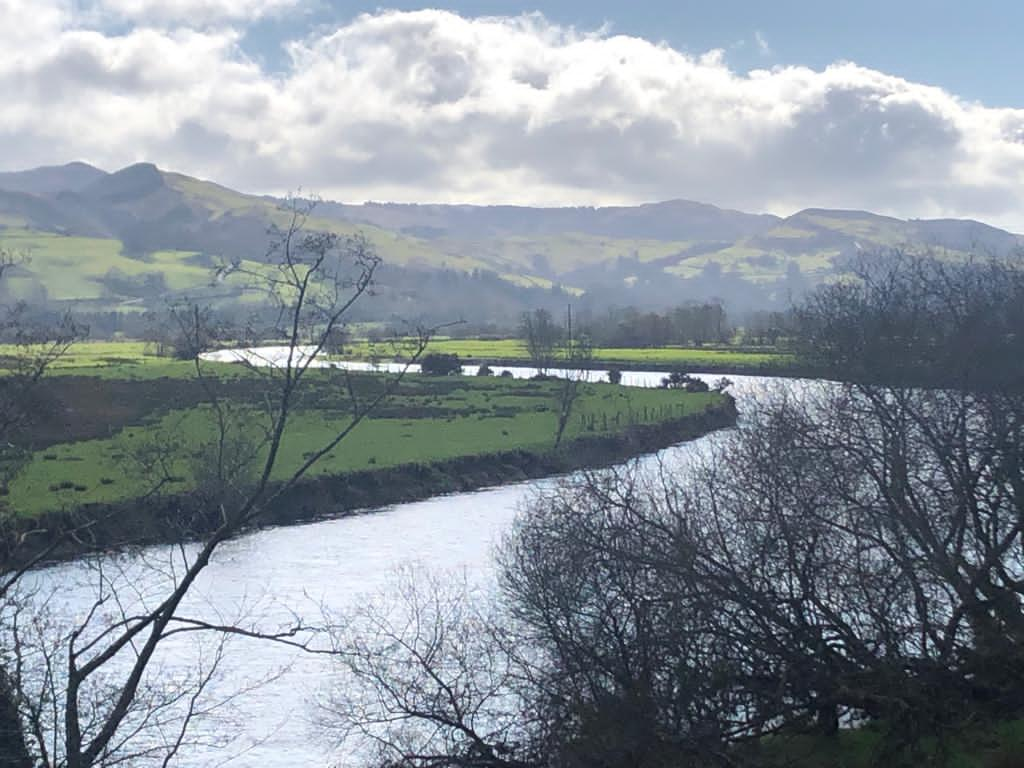
It is a blue-sky morning, fat with the promise of early spring and I am standing at the bottom of a tight, single-track road just across the river from where I live. The road rises steeply to the north, winding through pastures and woodland, until eventually it reaches the open hill country above. I feel full of expectation, eager for clues of renewed life. At first sight the place looks unchanged since Christmas: the ground hard and bony, grass cropped short and the trees bare, but I can smell new growth: a rising succulence that is putting new flesh on winter bones. There is fresh unfolding foliage on honeysuckle, cleavers, herb Robert and cow parsley. Yellow stars of celandines light up the hedge bank with a brassy optimism, the plain white flowers of barren strawberry around them are like maids attending a dowager. Above me a goldcrest is stitching its high frequency song whilst a crow yells in a coarse f-off sort of way from nearby woodland. Abruptly a pheasant coughs like somebody tearing metal. A lizard, my first of the year, is more movement than image, slipping between dead grass and emerging nettles.
Further up a scruffy little pasture catches my eye: drab grey-green with scattered rushes and bracken, it is quite unlike the overfed verdance of the valley bottom grassland. This small field is steep (which no doubt saved it) and full of hummocks and jutting bedrock – and best of all a sprinkling of grassy anthills, a sure sign it has been spared the plough. Such places sometimes contain botanical gold, so I will be back in a month or two.
Turning round and looking south the escarpment edge of the Cambrian Mountains, although five miles from here, is sharp enough to cut your finger on today. In the foreground the river, a glittering blue slash across the landscape, looks benign and easy, but only days ago it bulged ominously with coffee coloured water moving with a remorseless force. En route from Aberystwyth to Shrewsbury a train trundling along the valley gives a mournful hoot: a come-hither sound that has me longing to travel. It has been a hard year.
In the hedgerow a patch of dog’s mercury is fresh up from the soil, the tiny cream and green flowers just beginning to open. I am always pleased to see this modest plant; it is said to be an indicator of long gone woodland and as so many of our plants originated on the wildwood edge a hedge is a good enough proxy. A group of long-tailed tits are making their way along the lane from bush to bush in busy conversation; they seem oblivious of me – like people overheard on a bus.
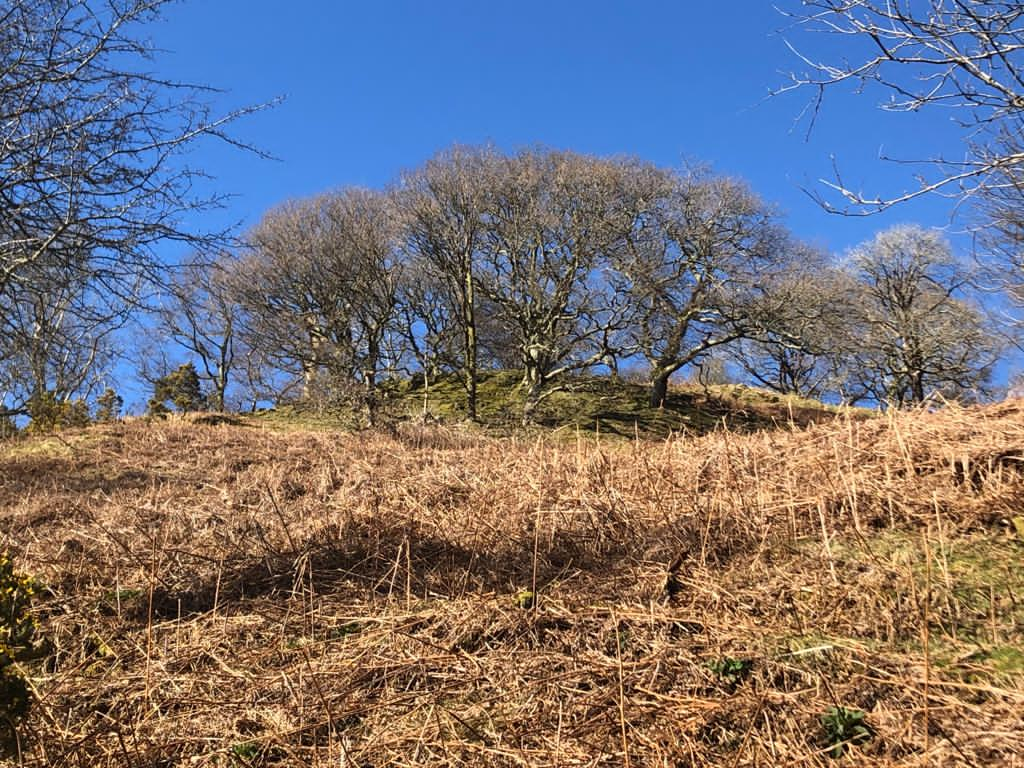
Further up the lane the ground opens out into steep hard-bitten grassland strewn with last year’s brittle and flattened bracken. It is hard to imagine the forest of sappy fists it will be thrusting up in just a few weeks. The slope rises to a group of elderly oaks through which a raven sidles discreetly off stage. I can’t see a nest, but it is that time of year for ravens. A scattering of gorse is (as always) flowering but otherwise this slope looks closed, still in the grip of winter. Some of the oaks have shed limbs – a glorious chaos of lichen and rot. I offer up a silent prayer that they wont be tidied up, but a stack of logs at the roadside looks ominous. One or two trees lie prone, punched flat by distant gales, their root plates rotated to vertical. It is a miracle that they stand for so long in these shallow shaley soils, their sclerotic roots clinging on for dear life.

At this point the trickle beside the road runs into a kind of slate cistern, the sort of thing a posh garden centre would rob you blind for – but here, made long before artisans drank lattes, it is half overgrown and entirely forgotten. A bit further up, where the road crosses a stream, a dry-stone wall made from thousands of slate shards is twisted out of shape by tree roots, but it still supports the bank. It is hard to imagine the patience and fortitude needed to make such a thing for seemingly such a slight purpose. It reminds me of Andy Goldsworthy’s work, which shines a light on the everyday artistry that was once everywhere and nowhere in the countryside.
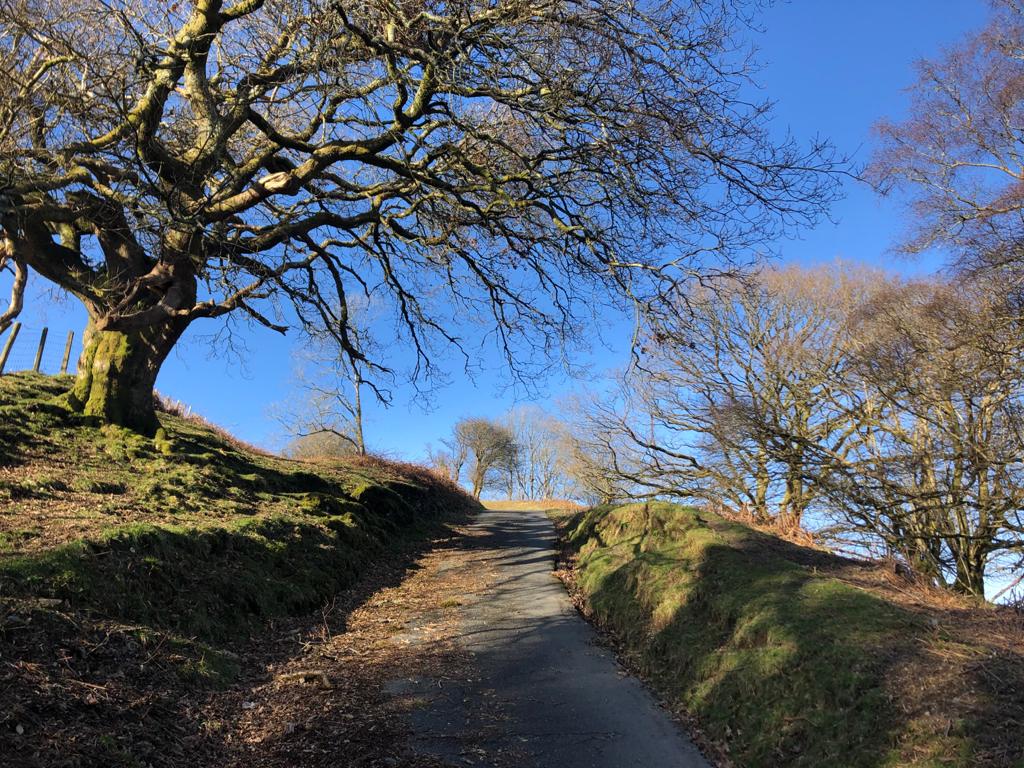
Either side of the lane is now open hill land. The tarmac has disintegrated into a loose rutted track with patches of exposed bedrock. I’m pleased to reach the top, the break in slope before the track slides down into the next valley. Spread out in front of me is a huge bowl with woodland and forestry plastered around the sides of the surrounding hills. It still feels hard and unforgiving up here, a few hundred feet make a lot of difference at this season. The hedgerow plants have gone, the birds are quiet and the wind suddenly has a bite. Not yet the glories of skylarks in their towers of song or small butterflies dancing across the warm turf.
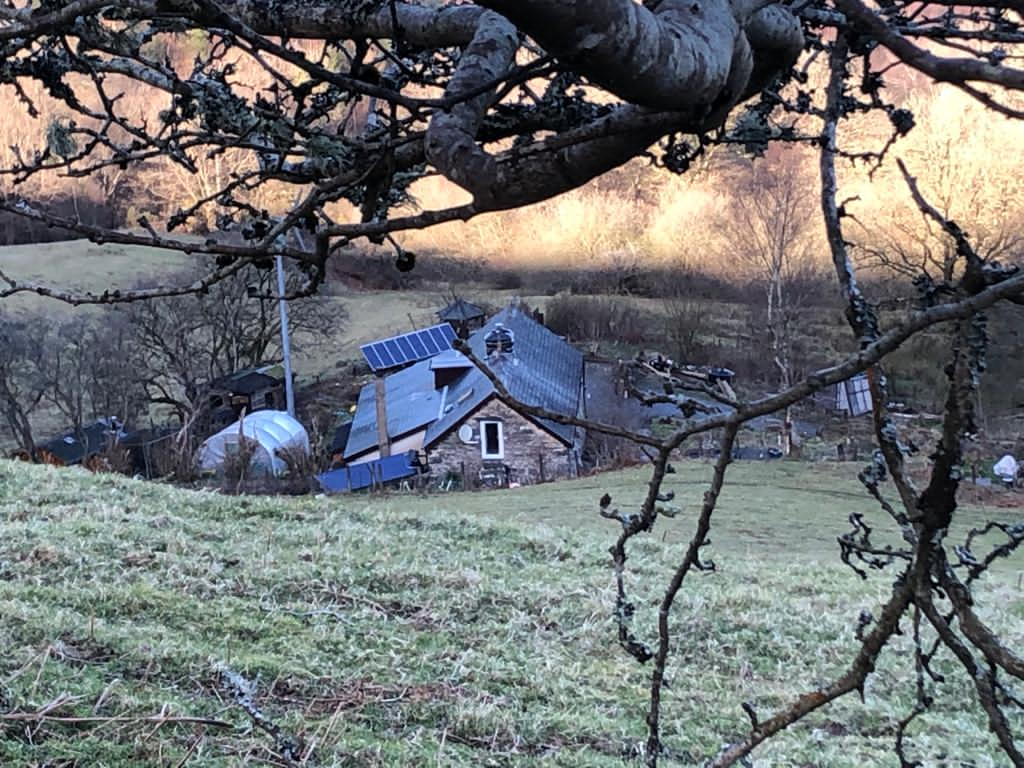
Tucked under the slope150 feet below me is Bron yr Aur, a remote one-time farmstead now impressively ‘off grid’ with a wind turbine, hydro and a solar array. It was here, sometime in the late 1960s, that Led Zeppelin started writing ‘Stairway to Heaven’ – one of the greatest rock songs of all time; apparently Bron yr Aur is still a place of pilgrimage for fans. It is a seductive thought that this road inspired their title, but really I have no idea if their stairway to heaven is the same as mine.

At the beginning of the week we had the sort of rain that would have got Noah out of his armchair: this culminated in the river Dyfi spilling millions of gallons of water onto the floodplain until there was a veritable sea downstream from the bridge. For 24 hours Machynlleth became cut off from both north and south, and at least one home was badly flooded. By Thursday the waters had subsided again leaving a tangle of debris and broken fences for the farmers to clear up.
On Friday it turned frosty and this morning we woke to the brightness of snow: the landscape was transformed once again. I got out early but at least one lot of dog walkers was ahead of me. Crunching and snapping underfoot in tiny seismic explosions the snow clung to every twig and branch in gobbets or delicately frozen filigrees. Yellow gorse flowers glowed like struck matches inside crystalline cages. My terrier dashed about nose to the ground – what is it about snow that seems to amplify scent trails? The sky was bruised purple and looked fit to burst. I met a couple of other wide-eyed, snow-struck walkers: “more on the way” we pronounced knowingly.
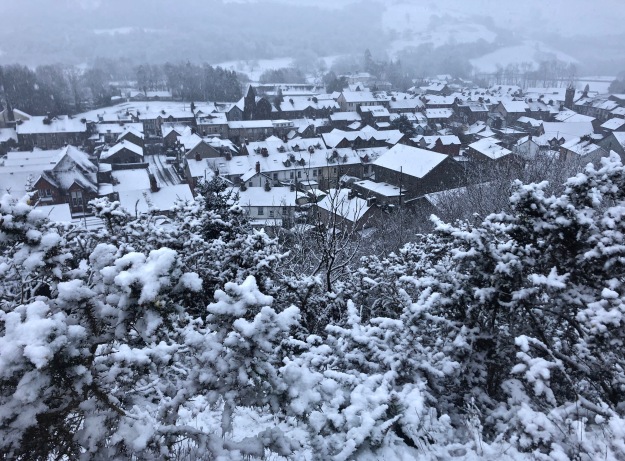
I was enjoying myself, but for many people all this ‘weather’ on top of a remorseless deluge of Covid news at the fag-end of January, must seem like the pits. Being forced to live in the shaky gap between vaccination and infection, in a closed-up town dumped on by floods and ice – is too much.
But, of course, this grim story is only one version of what is going on: It was light until 5.30 yesterday evening; I heard my first song thrush give voice – admittedly rather tentatively, less strident for now; some snowdrops have turned down their bells, dreaming of early pollinators; and the rooks at the bottom of our road are in constant conversation about the new season. It seems to me that we are no longer looking into winter but out towards spring.
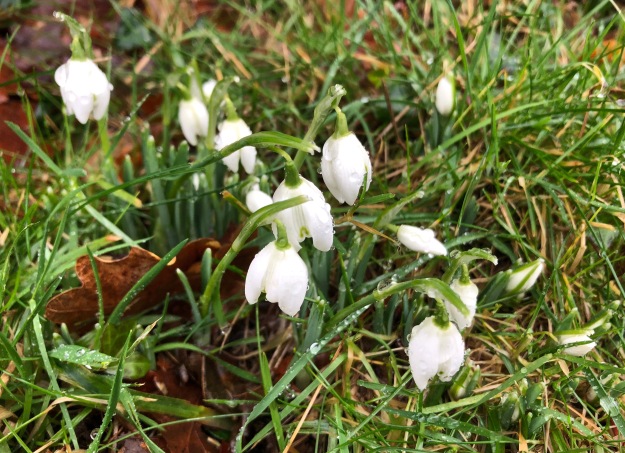
But walking home through the muffled town I was reminded of this ‘life depends on your viewpoint’ stance when I noticed a blackbird foraging in the gutter, no more than a yard away. I was charmed by its confiding behaviour until it struck me that this wasn’t friendliness but desperation. If the snow and ice persist it will be hard pushed to find enough calories to make it through the night. Cute though it looked, cocking a bright yellow eye at me, it was trying to survive in the mortal gap between enough and too little. Mostly our affluence masks the inherent fragility of life but Covid has ripped this away – leaving us as vulnerable as a blackbird on an icy morning.
The rain is hammering down on the metal roof and the wind rattles every loose corrugated sheet but still the glorious voices of the singers rise up, soaring above the racket. A sense of community and common purpose is palpable – it feels like a triumph of spirit over adversity.
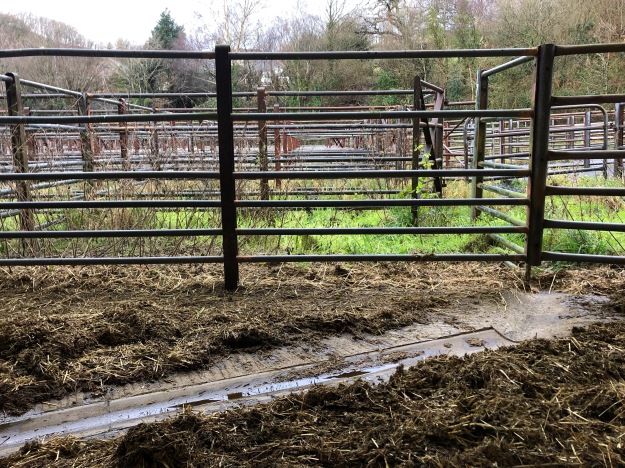
We are standing in an enormous open-sided shed in the middle of Machynlleth’s livestock market; the floor is gridded out with sturdy metal pens, which 3 days ago were crowded with jostling sheep. Each of us, in a group or singly, has our own pre-booked animal pen to ensure social distancing – the straw and dung has thankfully been swept aside. At the front, performers from Mid Wales Opera are giving it their all – delighted to be in front of a live audience for the first time in months. Pop-up opera in a sheep shed – where else but Wales could these two so readily share a bed.
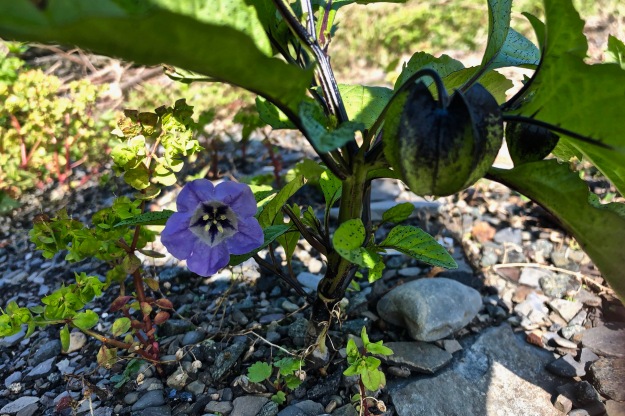
As it happens this place was a haunt of mine during the first lockdown due to the interesting flora that grows here. In the scrubby margins, rough grass and disused animal pens all sorts of plants eke out an unlikely living. Some of them no doubt arrive here with the dung and straw, on the fleeces of the sheep or even the tyres of the vehicles that come from far and wide every market day. I found oddities like Apple of Peru, Fool’s Parsley and even a discarded potato, whose flowers were as lovely as I saw all summer. Others like Red Bartsia, Common Mallow and Dovesfoot Cranesbill inhabit the tussocky grass – scuffed patchily into seedbeds by wheels and hooves. Other species thrive in the undisturbed scrub that runs along one side of the mart: this was the only place in the district where I found our native Goldenrod and Broad-leaved Helleborine. The latter is an orchid, several of which were unusually vigorous and packed with flowers, despite having emerged from ground sprayed lifeless with weed killer.
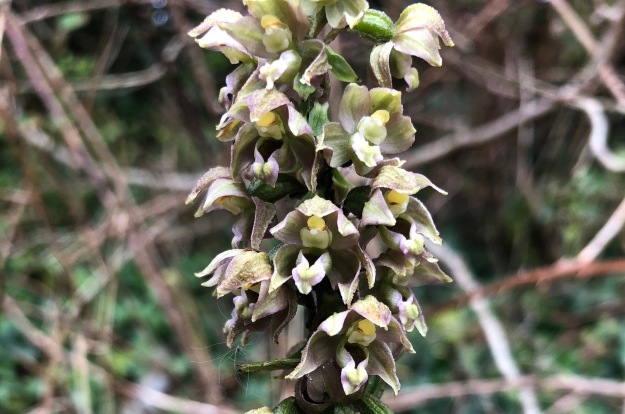
Remembering these tenacious plants as I listened to the final rousing carol filled me with a sense that life and spirit can overcome even the most difficult times and daunting odds.